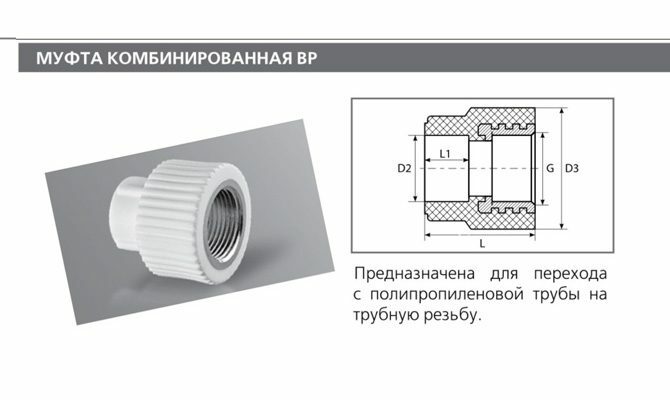The bathroom should be beautiful, convenient, comfortable, functional and hygienic. The mixer is mainly responsible for the functionality. It is installed both on the sink and in the area for taking water procedures: shower or bath.
It is not difficult to choose this device. But the types of bathroom faucets are a large number of models that differ from each other:
- type of connection to the water supply network;
- type of management;
- design.
The content of the article:
-
Types of faucets in the bathroom by type of connection
- Outdoor wall-mounted mixers
- Indoor wall mixers
- Mortise bathroom faucets
- Floor types of faucets in the bathroom
-
What are the types of mixers by control method
- Two-valve
- Single-lever
- Loktevoy
- Touchless (touch-sensitive mixer) for the bathroom
- Thermostat
- Where are the different types of bathroom faucets installed?
- Which types of bathroom faucets are better: two-valve or single-lever
- Criteria for choosing different types of faucets in the bathroom
- Mounting types
Types of faucets in the bathroom by type of connection
There are four positions:
- external to the wall;
- internal in the wall;
- built-in;
- floor.
It is recommended either to buy a mixer first, and then to build a water supply system under it. Or initially do the wiring, and then purchase a bathroom faucet. The first option is better. At the center of the choice are the taste preferences of the owner of the house, so he chooses the mixer for himself. And already under the plumbing fixture they carry out a water supply network.
Let's look at the types of mixers by type of connection in more detail and create our own rating.
Outdoor wall-mounted mixers
Appliance attaches to pipes that come out of the wall in the bathroom. It is located completely outside. For him, first, piping is made, where the distance between the cold and hot water circuits will be standard - 15 cm, with a deviation of 1.5 cm in one direction or the other. If the error exceeds the value, then during the installation of the mixer, eccentric adapters are used.
These mixers can also be attached to acrylic bathtubs. You cannot install them in cast iron. Even in Soviet times, plumbing fixtures were mounted directly above the bathroom. They had a long spout or spout. He provided water for both the sink and the bath. Many are accustomed to this, so most European manufacturers supply faucets to Russia with a long spout (25-39 cm), which rotates at the point of joining with the main body.
For Europeans, this is an inconvenient option because the more rotation points, the faster the mechanism wears out. Therefore the European standard is a short, non-rotating spout. These are also sold in Russia.
As for the piping, it is often done hidden, recessed into the wall. Previously, there was an open version, because steel pipes quickly failed and they had to be replaced with new ones. Today, designers use the hidden location of communications as an industrial style design in the interior of the bathroom.
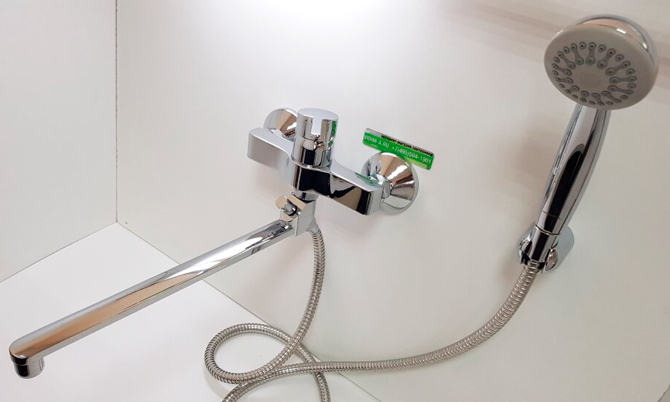
Indoor wall mixers
These models precisely define their name. The spout and controls are usually visible from the wall. Everything else is in it. The controls from the gander can be located at a distance. This applies to a mixer with a shower, where the shower head will be overhead, and the control system will be at waist or hand level.
This arrangement complicates the repair of the plumbing fixture. Therefore, it is recommended to buy a quality model.
Mortise bathroom faucets
There are two options here:
- with installation on the side of the bath;
- on the sink.
Structurally, both instances do not differ from each other. Both are installed in holes made in the structure of the plumbing fixture. For the sink, they can be made in the countertop on which the latter is mounted.
The set of mortise mixers includes a system for regulating the supply of cold and hot water, a spout. The latter for the sink is the standard version with a non-rotating spout. For a bath, this is the same, plus - a watering can on a hose or pipe.
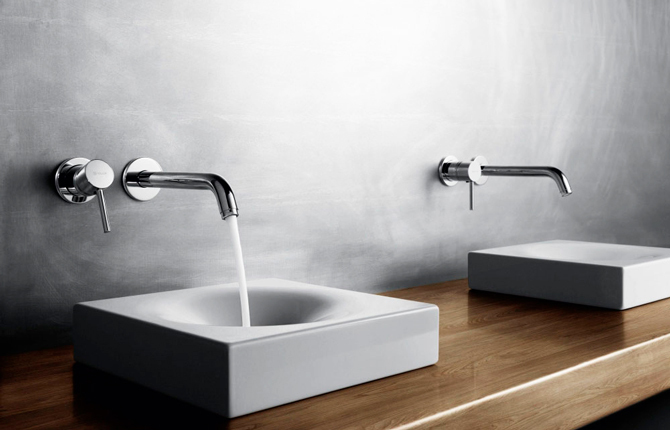
Floor types of faucets in the bathroom
This type of bathtub shower mixer is not very popular. It got its name from the place of installation - on the floor next to the bathroom.
Structurally, this is a rack where the pipe connection is hidden. A spout and a watering can on the hose are attached to it. There are models with two racks, in each of which they are hidden - in one there is a supply of cold water, in the other hot. Their height can be up to 1.5 m.
Advantages:
- no pressure is created on the bath;
- unusual appearance;
- the height is adjusted to the requirements of the customer;
- it is a free-standing structure, therefore, when carrying out repairs, there is no need to touch other types of plumbing fixtures;
- the scope of application of such mixers is not limited: bath, sink, pool, etc.
Minuses:
- the price is higher than standard modifications;
- the appliance in the bathroom takes up space;
- you will have to pay for the installation - it is not easy to carry out the installation with your own hands.
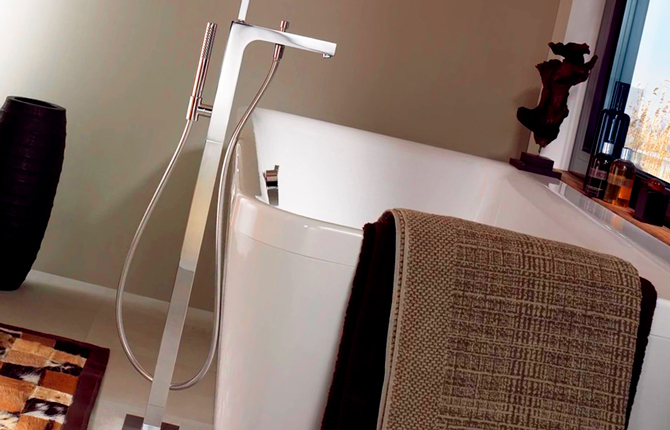
What are the types of mixers by control method
The ease of use of the mixer is based on the type of control. If earlier only two options were presented - with the help of valves and a lever - today the range has expanded. Consider the varieties and choose the type you like the most.
Two-valve
The set of the device includes two valves: one for supplying cold water, the other for hot. They are located on either side of the spout, indicated by different cap colors: red for hot water, blue for cold water.
Structurally, manufacturers offer two options for water supply:
- worm;
- ceramic.
The first are classics. This is a crane box, into which a worm-threaded stem is inserted. Turning the latter clockwise, close the feed. And vice versa. At the end of the stem, there is a rubber or paronite gasket that closes the hole. Through the latter, water is supplied. The model is convenient because it can be easily repaired. Usually the same gasket fails, which is easy to replace.
The second is a more modern look. Inside the body of the mixer there is a ceramic valve-axle box, in which slots are made. Through them, water enters the spout when aligned with the slots of the hole in the body.
You can distinguish which view is installed by the number of revolutions. To fully open the water supply, the worm version must be scrolled around the axis several times. Ceramic opens in one turn.
Advantages:
- low price;
- ease of use;
- simple repair;
- small overall dimensions;
- installation is simple;
- high reliability.

Single-lever
In another way, this type of mixer is called single-gripping. The water supply is adjusted with one lever mounted on the body of the device. Hence the name itself.
There are two models in this category:
- cartridge;
- spherical.
The first is a cylindrical ceramic cartridge installed in the mixer body. Through-slots are made in it for water supply. The second is a metal hollow ball with three slots: one outlet and one inlet. Inside the ball, cold and hot water is mixed, after which the mixture flows out through the spout.
Advantages:
- the convenience of use;
- quick regulation of temperature and water flow, which saves the latter;
- both are much more durable than valve designs.
Flaws:
- the incoming water must be as clean as possible, otherwise the cartridge or ball will quickly fail;
- repairs are easy, but the cartridge and the ball are many times more expensive than rubber gaskets;
- both types are more expensive than their valve counterparts.
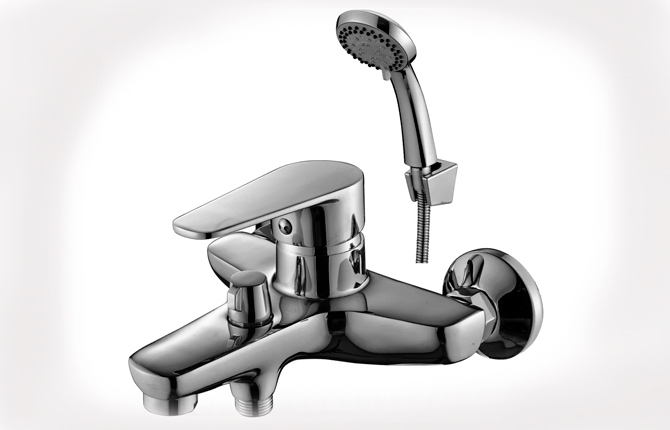
Loktevoy
This is the same lever view. It's just that the lever has a bent upward shape, plus it is longer than that of standard models. Such mixers were used in medical institutions, especially in operating rooms, where it was required to minimize hand contact with objects and devices.
In the bathroom, this variety immediately took root. Manufacturers offer single-lever and double-lever types. The latter are devices with two cartridges and separate levers for cold and hot water. They are similar to two-valve, only levers are installed instead of lambs.
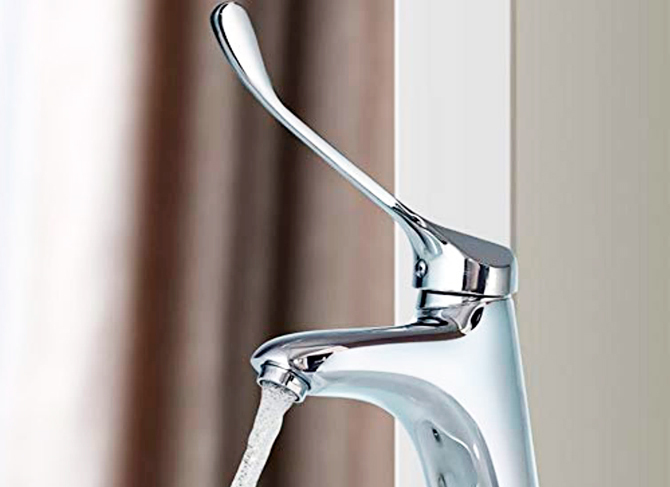
Touchless (touch-sensitive mixer) for the bathroom
This is a technologically advanced type, the control of which takes place without contact between hands and the mixer. In the design of the latter, an infrared sensor is mounted, which reacts to hands brought to the end of the spout.
This modification is divided into two groups:
- water is poured out for a certain time, when the hands are put under the gander;
- the pouring time is unlimited.
Manufacturers offer devices that regulate the temperature of the water themselves. The closer your hands are to the end of the spout, the hotter the water pours out of it.
Design features:
- small dimensions due to the absence of levers and valves - instead of them an automatic valve is installed;
- the infrared sensor can work either from batteries or from a 220 volt alternating current;
- some models are equipped with an aerator to reduce water consumption;
- like other types, this variety can be completed with a shower, mesh or water heater.
The price is high, but this is justified by the economical fluid consumption. The device will serve for a long time. But if it breaks, then it will not be easy to repair it. The reason is the complexity of the design.
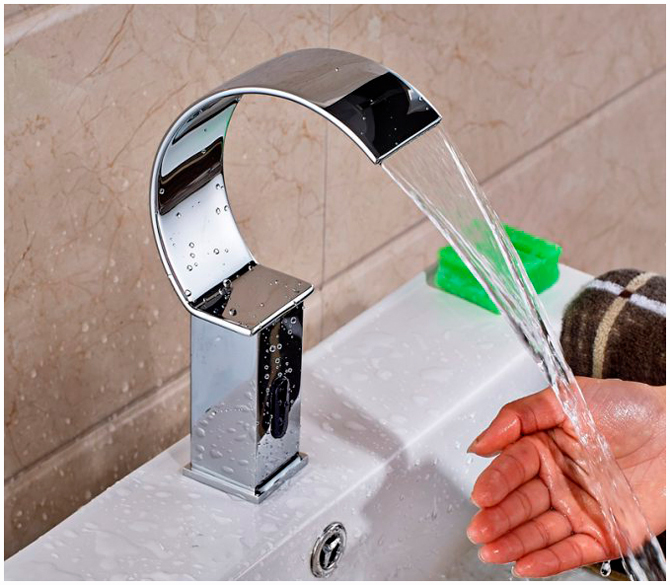
Thermostat
Name thermostatic mixer based on one important function - to mix hot and cold water to the required temperature. At the same time, the flow force is also standard.
Consists of:
- hulls;
- thermostatic valve: rubber or ceramic;
- pressure regulator.
The temperature can be adjusted manually by pressing buttons (mechanical model) or on the screen (touch model). The first option is simpler, hence the high reliability.
Advantages:
- increased usability - standard temperature and flow rate, which can be adjusted to suit your requirements;
- increased security;
- saving water - not a single drop will be wasted during the setup process;
- good aesthetic characteristics.
Flaws:
- high price relative to other analogues;
- the complexity of the repair, which will not be cheap.
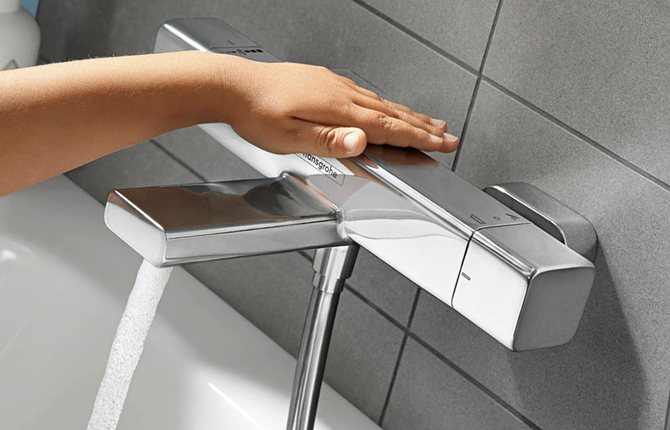
The best type of bathroom faucets in terms of control method and type of installation from sovet-ingenera.com:
Outdoor wall-mounted mixers
1
Two-valve
1
Single lever
1
Loktevoy
1
Thermostat
1
Indoor wall
0
Sensory
0
Indoor wall mixers
-1
Floor
-1
Where are the different types of bathroom faucets installed?
Places to install the mixer:
- bath;
- sink;
- bidet;
- shower.
There are universal models that fit one or two plumbing fixtures. For example, one option is suitable for showers and baths - with a watering can. The same, only in a reduced form, for the bidet.
For the sink, choose a device that, in all respects, is suitable for it. The shape and size should be taken into account here. The larger the latter, the longer the gander should be.
If a sink without holes is installed in the bathroom, then the mixer is installed on the countertop. A distinctive feature of such models is a high body, a long spout.
Which types of bathroom faucets are better: two-valve or single-lever
There is no definite answer here. Each type has its positive and negative sides. Therefore, it is worth choosing a device according to the style of the bathroom interior. For example, a valve will look great in a retro-styled room. Single-lever will fit into modern style trends.
Which look do you like best from an aesthetic point of view?
Single-lever.
0%
Two-valve.
100%
I prefer a different look in the interior.
0%
Voted: 1
Criteria for choosing different types of faucets in the bathroom
The first selection criterion is the material from which the device is made. The best is brass, others do not withstand intensive use for a long time. If a mixer with a ceramic cartridge is chosen, then the plates should be made of wear-resistant aluminum oxide. It is fired at a temperature of +1200 ℃, plus under pressure. Some manufacturers use ultrasonic grinding on the cartridge to improve quality and durability.
Ball parts must be made of stainless steel. This also applies to fasteners.
Many foreign companies prefer high-strength plastics. Covers for housings, handles, watering cans and more are made from it. The quality does not suffer from this.
About coverage - there are many types:
- enamel;
- chromium;
- nickel;
- gold.
Enamel is beautiful. But it fights back under shock loads. Gold is expensive. Nickel causes allergies in some people. Therefore, chromium remains, on which harmful microorganisms do not multiply. And although traces of water remain on the chrome surface, it is better to give preference to it.
With regard to levers or other controls, it can be noted that manufacturers pamper consumers in this regard. Here marble, stainless steel, chrome-plated steel, glass, crystal. From unusual materials - wood, polished onyx, a combination of two or more types.
The second selection criterion is the manufacturer's warranty. For example, German brands guarantee trouble-free operation for five years, Czech brands - up to 10 years.
The third position is the pressure in the water supply system. This is especially true for hot water supply.
It is better not to save on the mixer. It is better to spend money once and install a good device than to change a cheap one every year.

Mounting types
There are two types of fixing for mixers:
- to water pipes through union nuts;
- through flexible liners.
The first option is the nuts that are included with the device. Inside them, rubber or polymer seals are laid, ensuring the tightness of the pipe-mixer joint. This type of attachment is used for both the bathtub and the sink.
The second option is a mixer, to which two flexible liners are bought, they are also hoses. Today, most manufacturers complete the appliance with these hoses. This option is used in the bathroom only for the sink.
The lead-in can be with union nuts or with special finger adapters. They are chosen depending on which connection option is at the mixer itself.
What type of bathroom faucet to choose depends not only on the preferences of the owner of the apartment or house. It is necessary to take into account many criteria - from the water supply scheme to the design of these sanitary products. If you know all the nuances, then you can purchase a mixer that will perform its functions 100%.
How to choose the right bathroom faucet: video.
I would like to hear from readers who have had the experience of buying a mixer, which points were paid attention to in the first place? Let us know in the comments. Save the article to bookmarks, share it on social networks.
